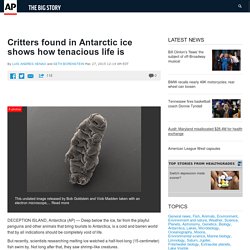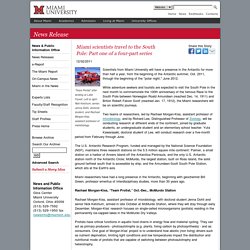

Bigstory.ap. DECEPTION ISLAND, Antarctica (AP) — Deep below the ice, far from the playful penguins and other animals that bring tourists to Antarctica, is a cold and barren world that by all indications should be completely void of life.

But recently, scientists researching melting ice watched a half-foot-long (15-centimeter) fish swim by. Not long after that, they saw shrimp-like creatures. In even more remote places on the continent, areas that haven't been exposed to sunlight for millions of years, scientists found a surprise right out of an alien movie: the DNA of a microscopic creature that looks like a combination of a bear, manatee and centipede. Life that is simultaneously normal and weird, simple and complex thrives in this extreme environment. To the scientists who brave the cold and remoteness to find life amid the ice, it's a source of surprise and wonder. "It really shows how tenacious life is," said Reed Scherer, a micropaleontology professor at Northern Illinois University.
Bigstory.ap. CAPE LEGOUPIL, Antarctica (AP) — From the ground in this extreme northern part of Antarctica, spectacularly white and blinding ice seems to extend forever.

What can't be seen is the battle raging thousands of feet (hundreds of meters) below to re-shape Earth. Water is eating away at the Antarctic ice, melting it where it hits the oceans. As the ice sheets slowly thaw, water pours into the sea — 130 billion tons of ice (118 billion metric tons) per year for the past decade, according to NASA satellite calculations. That's the weight of more than 356,000 Empire State Buildings, enough ice melt to fill more than 1.3 million Olympic swimming pools.
And the melting is accelerating. In the worst case scenario, Antarctica's melt could push sea levels up 10 feet (3 meters) worldwide in a century or two, recurving heavily populated coastlines. Parts of Antarctica are melting so rapidly it has become "ground zero of global climate change without a doubt," said Harvard geophysicist Jerry Mitrovica. Living and Working at the Amundsen-Scott South Pole Station, Antarctica, Summer 2012-2013 - Jeffrey Donenfeld. I have climbed the Seven Summits (tallest peaks on all seven continents), skied to the North and South Poles, and am on the part-time faculty at West Point. Ask Me Anything. : IAmA.
Miami University News: News Release. Scientists from Miami University will have a presence in the Antarctic for more than half a year, from the beginning of the Antarctic summer, Oct. 2011, through the beginning of the "polar night," June 2012.

While adventure seekers and tourists are expected to visit the South Pole in the next month to commemorate the 100th anniversary of the famous Race to the South Pole between Norwegian Roald Amundsen (reached Dec. 14, 1911) and Briton Robert Falcon Scott (reached Jan. 17, 1912), the Miami researchers will be on scientific journeys. Two teams of researchers, led by Rachael Morgan-Kiss, assistant professor of microbiology, and by Richard Lee, Distinguished Professor of Zoology, will be conducting research at different ends of the continent, joined by graduate students, an undergraduate student and an elementary school teacher. Yuta Kawarasaki, doctoral student of Lee, will conduct research over a five-month period from February through June. Polar Explorer Eric Larsen. Teaching Kids NewsPrince Harry Spends A Night In A Giant Freezer - Teaching Kids News. Prince Harry trained for his expedition in a “giant freezer.”

Photo: robertleverittphotography.com Britain’s Prince Harry spent a night in a giant freezer, to prepare himself for a race to the South Pole in November. He will be doing the 15-day trek with a team of wounded British soldiers. His team will compete against teams from the United States and the Commonwealth. Race for the South Pole: The Expedition Diaries of Scott and Amundsen: Roland Huntford: 9781441169822: Amazon.com: Books.
Race for the South Pole: The Expedition Diaries of Scott and Amundsen: Roland Huntford: 9781441169822: Amazon.com: Books. ZOOM SCHOOL Antarctica by EnchantedLearning.com. Amundsen, Race to the South Pole. "September 12—Tuesday.

Not much visibility. Nasty breeze from S. -52°C. The dogs clearly affected by the cold. The men, stiff in their frozen clothes, more or less satisfied after a night in the frost … prospect of milder weather doubtful. " The writer of this terse diary entry was Roald Amundsen, a Norwegian explorer who had won renown five years earlier for being the first to sail the Arctic's fabled Northwest Passage from the Atlantic to the Pacific.
Winning the South Pole, however, was not to be taken for granted. These glaring errors are worth dwelling on not to find fault with Amundsen but to dispel a myth that has long claimed him: His attainment of the Pole was just a passionless application of expertise and cold ambition, and Amundsen himself, therefore, was a colorless professional. The false start of September 1911 is a reminder that there is no such thing as an inevitable outcome in the risky enterprise of polar exploration.